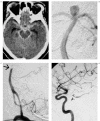Thromboembolic complication induced stable occlusion of a ruptured basilar tip aneurysm. Case report and review of the literature
- PMID: 20377984
- PMCID: PMC3277964
- DOI: 10.1177/159101991001600111
Thromboembolic complication induced stable occlusion of a ruptured basilar tip aneurysm. Case report and review of the literature
Abstract
We describe a case of a ruptured basilar bifurcation aneurysm that thrombosed during preparation for endovascular therapy as a complication of diagnostic angiogaphy, and showed a favorable evolution during long-term follow-up. Endogenous thrombosis of ruptured, non giant aneurysms is uncommon. The persistence of occlusion over time in such cases is not well established. Two weeks after rupture, a 6 x 8 mm basilar bifurcation aneurysm was referred for endovascular treatment. During preparation for endovascular coil occlusion, without having any endovascular material at the level of the basilar artery, a complete thrombotic occlusion of the basilar bifurcation and aneurysm was observed. Given the good collateral circulation for both posterior cerebral arteries no thrombolysis was undertaken. The early follow-up of seven days, three and six months showed a complete recanalization of the basilar artery and remodeling of the basilar bifurcation. The 20 months imaging follow-up demonstrated a small aneurysm regrowth at the prevoius location that remained stable during the follow-up of seven years. Unchanged biological and hemodynamic characteristics. however, may pose an elevated risk of a new aneurysm formation over time, making long-term imaging follow-up, and in case of progression, aneurysm occlusion necessary for the patient.
Figures



Similar articles
-
Early endovascular treatment for ruptured basilar bifurcation aneurysm--case report.Neurol Med Chir (Tokyo). 1995 May;35(5):314-6. doi: 10.2176/nmc.35.314. Neurol Med Chir (Tokyo). 1995. PMID: 7623954
-
Successful thrombolysis in the vertebrobasilar artery after endovascular occlusion of a recently ruptured large basilar tip aneurysm.AJNR Am J Neuroradiol. 1995 Apr;16(4 Suppl):847-51. AJNR Am J Neuroradiol. 1995. PMID: 7611055 Free PMC article.
-
Endovascular Management of a Ruptured Basilar Perforator Artery Aneurysm Associated with a Pontine Arteriovenous Malformation: Case Report and Review of the Literature.World Neurosurg. 2018 Aug;116:159-162. doi: 10.1016/j.wneu.2018.05.051. Epub 2018 May 16. World Neurosurg. 2018. PMID: 29777889 Review.
-
Abciximab in patients with ruptured intracranial aneurysms.AJNR Am J Neuroradiol. 2005 Aug;26(7):1744-50. AJNR Am J Neuroradiol. 2005. PMID: 16091524 Free PMC article.
-
Unassisted and multiple microcatheter coiling of distal basilar aneurysms: Outcomes and literature review.Interv Neuroradiol. 2022 Apr;28(2):169-176. doi: 10.1177/15910199211021718. Epub 2021 May 30. Interv Neuroradiol. 2022. PMID: 34053314 Free PMC article. Review.
Cited by
-
Delayed ipsilateral parenchymal hemorrhage following flow diversion for the treatment of anterior circulation aneurysms.AJNR Am J Neuroradiol. 2012 Apr;33(4):603-8. doi: 10.3174/ajnr.A3065. Epub 2012 Mar 8. AJNR Am J Neuroradiol. 2012. PMID: 22403783 Free PMC article.
-
Endovascular revascularization for basilar artery occlusion.Interv Neurol. 2015 Jan;3(1):31-40. doi: 10.1159/000368968. Interv Neurol. 2015. PMID: 25999990 Free PMC article. Review.
-
Hemodynamics of cerebral aneurysm initiation: the role of wall shear stress and spatial wall shear stress gradient.AJNR Am J Neuroradiol. 2011 Mar;32(3):587-94. doi: 10.3174/ajnr.A2339. Epub 2011 Feb 10. AJNR Am J Neuroradiol. 2011. PMID: 21310860 Free PMC article.
References
-
- Brownlee RD, Tranmer BI, et al. Spontaneous thrombosis of an unruptured anterior communicating artery aneurysm. An unusual cause of ischemic stroke. Stroke. 1995;26(10):1945–1949. - PubMed
-
- De Luca GP, Volpin L, et al. Spontaneous healing of cerebral aneurysm at the beginning of left posterior inferior cerebellar artery (PICA). Case report. J Neurosurg Sci. 1998;42(2):115–118. - PubMed
-
- Maiuri F, Iaconetta G, et al. Spontaneous cure of a ruptured intracranial aneurysm. Acta Neurol (Napoli) 1993;15(2):106–113. - PubMed
-
- Sobel DF, Dalessio D, et al. Cerebral aneurysm thrombosis, shrinkage, then disappearance after subarachnoid hemorrhage. Surg Neurol. 1996;45(2):133–137. - PubMed
Publication types
MeSH terms
LinkOut - more resources
Full Text Sources
Medical

